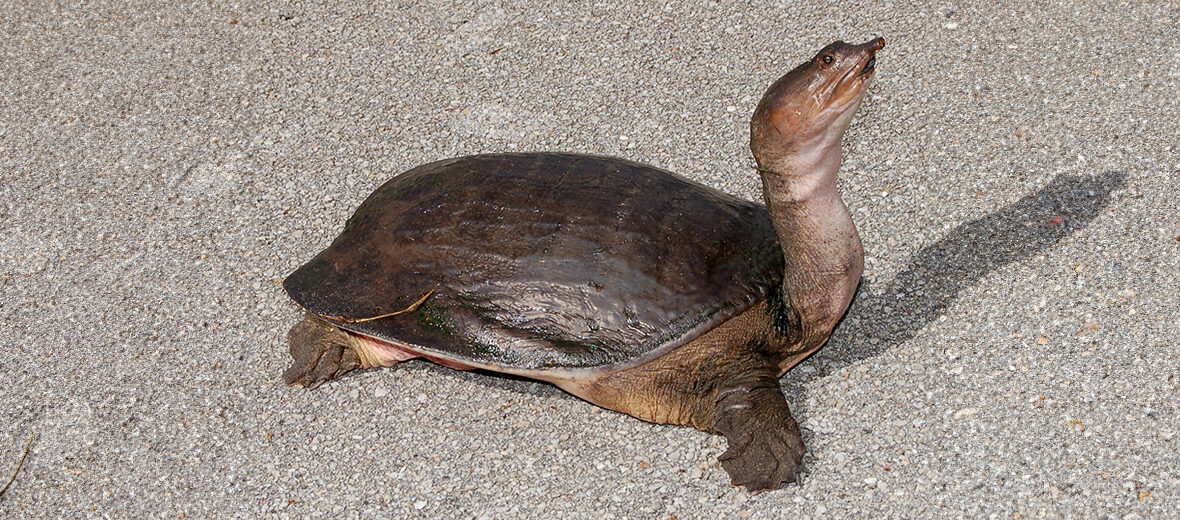
The Florida softshell turtle is sometimes confused with the snake-necked turtles of Australia or the Argentine snake-necked turtle of South America. However, there are differences not only in the obvious locales but also in their physical appearance. These turtles face the threats of habitat division at the hands of roads and railroads, which also result in vehicle strike (being hit by vehicles); overfishing; and over-harvesting. However, they are abundant enough to be classified as Least Concern by the IUCN. This article is dedicated to Lezli.
First the Stats…
Scientific name: Apalone ferox
Weight: Up to 96 lbs.
Length: Up to 29.9 inches
Lifespan: Up to 25+ years
Now on to the Facts!
1.) While primarily found in the state of Florida, they can also be found in the southern sections of Alabama, Georgia, and South Carolina.
2.) Out of the 3 species of softshell turtle in the United States, the Florida softshell turtle maintains the smallest geographic range.
3.) They dwell in nearly every freshwater habitat, they even tolerate some brackish (partially saline, or salty water) environments. They just require the water’s current to be slight or have none at all.
4.) These turtles prefer creeks, lakes, marshes, wet prairies, small rivers, swamps, and even ponds created in man-made ditches and/or sinkholes.
5.) While the majority or turtles possess hard shells made of scutes, Florida softshell turtles have a cartilaginous carapace (shell) covered in leathery skin.
But wait, there’s more on the Florida softshell turtle!
6.) They are the largest species of softshell turtle found in North America.
7.) Extreme sexual dimorphism exists in this species, as females are up to 5 times larger than males.
Did you know…?
Just like all softshelled turtles, they are fast moving on land and in the water.
8.) Males typically have longer tails than females.
9.) Being almost entirely aquatic, they typically only leave the water to bask in the sun or to lay eggs on the shore.
10.) Fish, insects, crustaceans, frogs, mollusks, waterfowl, and some plant matter, and seeds are all on the menu. Scavenging also takes place.
But wait, there’s still more on the Florida softshell turtle!
11.) Males produce sperm during the fall and store that sperm in the epididymides throughout the winter. This stored sperm can then be utilized for copulation during the following spring mating season.
12.) The females will nest between April – August.
Did you know…?
Florida softshell turtles will sometimes lay their eggs in unoccupied alligator nests, but they will sometimes even lay eggs in occupied alligator nests.
13.) Females have up to 5 egg clutches each season, with each clutch consisting of up to 38 eggs. The eggs take up to 90 days to hatch.
14.) The Florida softshell turtle has 1 of the highest annual egg production rates of any known reptile.
15.) These turtles generally rank high on the trophic scale (hierarchical levels in an ecosystem), generally functioning as secondary or tertiary consumers.
But wait, there’s still a little more on the Florida softshell turtle!
16.) That being said, alligators have been known to prey on the adults of these turtles, and raptors will sometimes take juveniles.
17.) Fish crows, foxes, raccoons, skunks, and river otters also raid their nests and prey on their eggs.
18.) Besides the previously mentioned threats, they also face the threat of being harvested for their meat.
Now a Short Florida Softshell Turtle Video!
Be sure to share & comment below! Also, check out the Critter Science YouTube channel. Videos added regularly!
Want to suggest a critter for me to write about? Let me know here.
Some source material acquired from: Wikipedia & IUCN
Photo credit: Johnskate17



